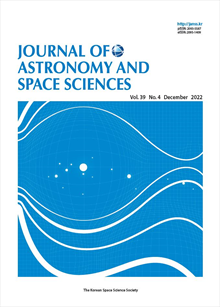간행물
Journal of Astronomy and Space Sciences KCI 등재 SCOPUS

- 발행기관 한국우주과학회
- 자료유형 학술지
- 간기 계간
- ISSN 2093-5587 (Print)2093-1409 (Online)
- 수록기간 1984 ~ 2022
- 주제분류 자연과학 > 천문학 자연과학 분류의 다른 간행물
- 십진분류KDC 443DDC 520
권호리스트/논문검색
제28권 3호 (2011년 9월) 9건
1.
2011.09
서비스 종료(열람 제한)
2.
2011.09
서비스 종료(열람 제한)
3.
2011.09
서비스 종료(열람 제한)
Kim, Jae-Hyuk, Park, Sang-Young, Kim, Young-Rok, Park, Eun-Seo, Jo, Jung-Hyun, Lim, Hyung-Chul, Park, Jang-Hyun, Park, Jong-Uk
4.
2011.09
서비스 종료(열람 제한)
5.
2011.09
서비스 종료(열람 제한)
To prepare for a future Korean lunar orbiter mission, semi-optimal lunar capture orbits using finite thrust are designed and analyzed. Finite burn delta-V losses during lunar capture sequence are also analyzed by comparing those with values derived with impulsive thrusts in previous research. To design a hypothetical lunar capture sequence, two different intermediate capture orbits having orbital periods of about 12 hours and 3.5 hours are assumed, and final mission operation orbit around the Moon is assumed to be 100 km altitude with 90 degree of inclination. For the performance of the on-board thruster, three different performances (150 N with Isp of 200 seconds, 300 N with Isp of 250 seconds, 450 N with Isp of 300 seconds) are assumed, to provide a broad range of estimates of delta-V losses. As expected, it is found that the finite burn-arc sweeps almost symmetric orbital portions with respect to the perilune vector to minimize the delta-Vs required to achieve the final orbit. In addition, a difference of up to about 2% delta-V can occur during the lunar capture sequences with the use of assumed engine configurations, compared to scenarios with impulsive thrust. However, these delta-V losses will differ for every assumed lunar explorer's on-board thrust capability. Therefore, at the early stage of mission planning, careful consideration must be made while estimating mission budgets, particularly if the preliminary mission studies were assumed using impulsive thrust. The results provided in this paper are expected to lead to further progress in the design field of Korea’s lunar orbiter mission, particularly the lunar capture sequences using finite thrust.
6.
2011.09
서비스 종료(열람 제한)
7.
2011.09
서비스 종료(열람 제한)
Lee, Dae-Hee, Han, Won-Yong, Park, Young-Sik, Park, Sung-Jun, Moon, Bong-Kon, Ree, Chang-Hee, Pyo, Jeong-Hyun, Jeong, Woong-Seob, Nam, Uk-Won, Lee, Duk-Hang, Park, Kwi-Jong, Bae, Soo-Ho, Rhee, Seung-Wu, Park, Jong-Oh, Kim, Geon-Hee, Yang, Sun-Choel, Kim,
8.
2011.09
서비스 종료(열람 제한)
9.
2011.09
서비스 종료(열람 제한)
A simulated network protocol provides the capability of distributed simulation to a generic simulator. Through this, full coverage of management of data and service handling among separated simulators is achieved. The distributed simulation environment is much more conducive to handling simulation load balancing and hazard treatment than a standalone computer. According to the simulated network protocol, one simulator takes on the role of server and the other simulators take on the role of client, and client is controlled by server. The purpose of the simulated network protocol is to seamlessly connect multiple simulator instances into a single simulation environment. This paper presents the development of a simulated network (simNetwork) that provides the capability of distributed simulation to a generic simulator (GenSim), which is a software simulator of satellites that has been developed by the Korea Aerospace Research Institute since 2010, to use as a flight software validation bench for future satellite development.

